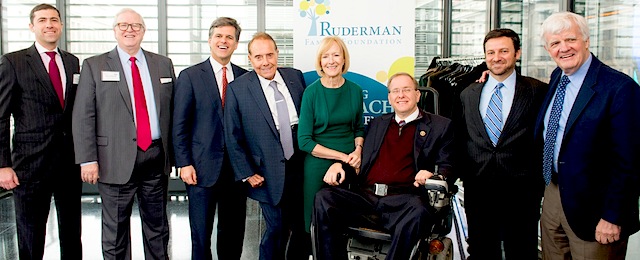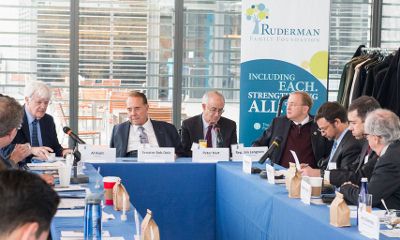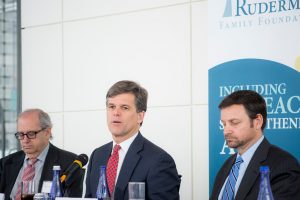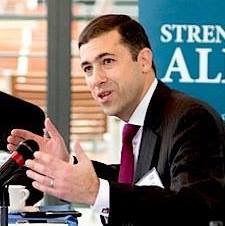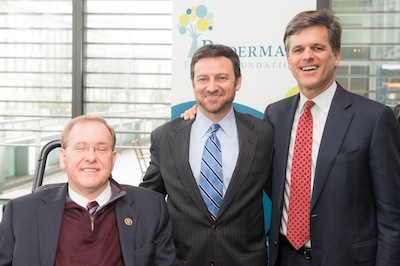
Connecting disabilities and decision-makers—Part II: Politics
December 22, 2015 /  0 Comments
0 Comments
By Shai Franklin
With Presidential primaries looming, so much international unrest and a global climate agreement in the works, the December 9 gathering of two-dozen top media and political figures, at Washington’s Newseum—among them former Senate Majority Leader Bob Dole, PBS NewsHour Anchor Judy Woodruff, Washington Post Executive Editor Martin Baron, Bloomberg columnist Al Hunt, political analyst Norm Ornstein, and legendary pollster Peter Hart—shouldn’t have surprised anyone. And yet, the addition of Special Olympics Chairman Tim Shriver and other leading disabilities activists, all convened by the Ruderman Family Foundation (RFF), made for a discussion that was both relevant and beyond the clutch of daily news cycles.
Following on last week’s blog post, which focused on disabilities in the news media, here are some highlights from the sessions dealing with disabilities in the political sphere, especially during a presidential election cycle:
Al Hunt’s opening question, on a panel he moderated with Senator Dole, Representative Jim Langevin (Democrat of Rhode Island), pollster Peter Hart and analyst Norm Ornstein, was why there is no serious mention of disabilities issues within the very crowded field of Republican candidates. Rep. Langevin acknowledged his frustration, and observed that Americans with disabilities fail to relaize their potential influence on the political process. This sizable sector needs to engage in ongoing and better organized outreach, and get better at how to communicate with legislators and candidates.
Andrew Imparato, Executive Director of the Association of University Centers on Disabilities (AUCD), referenced former Florida Governor Jeb Bush, who recently ran an online campaign video showcasing his work on behalf of people with disabilities. When Al Hunt noted that the Democrats running for President aren’t raising the disabilities issue, either, Rep. Langevin expressed his hope that Americans with disabilities could become the next big swing vote — and compel candidates to address their concerns.
RAISING VISIBILITY
As Peter Hart pointed out, a recent Harris poll showed that 70 percent of Americans have heard of the Americans with Disabilities Act (ADA), which was enacted 25 years ago. Across all demographic and party lines, over 80 percent support the ADA. The consensus begins to break down over who should qualify, with less acceptance of disabilities like alcoholism and obesity, which are often construed as “lifestyle choices”. And there is also often a gap between how much people tell the polling agency they care, and how much they really do.
According to Hart, what turned the tide on same-sex marriage was not some sudden breakdown of traditional values, but the sheer mass of Americans whose gay friends began coming out from the 1980s and into the 2000s. Once LGBT Americans were no longer hidden, this became an issue that affected most Americans. Americans with disabilities need to reach out and show Americans that they are neighbors, relatives, and friends. They need to stop being “an invisible constituency”.
Senator Dole, a disabled combat veteran of World War II, lamented that people with disabilities have not done more to mobilize themselves or their supporters, to get the American public engaged and interested. The Convention on the Rights of Persons with Disabilities (the “Disabilities Treaty”) is a good opportunity for raising awareness, especially since the United States has yet to ratify and therefore doesn’t get a seat at the table alongside other nations. He has been working closely with Ambassador Samantha Power, U.S. Permanent Representative to the United Nations, to secure ratification by the Senate. “We ought to be the examples,” he said. “Instead, we’re lagging behind.”
In the spirit of ADA, Rep. Langevin described how empowering people with disabilities to enter the workforce breaks down stereotypes and demonstrates the possiblities and advantages of full access and inclusion. It’s about “empowering people with disabilities to make their own choices.”
Norm Ornstein cited Richard Ben Cramer’s classic tome, What It Takes (1992), which portrays a truly dysfunctional political system, and one increasingly polarized along absolute lines of division. Having recently written about his own son, who died tragically while experiencing anosognosia (which rendered him unable to recognize he was ill), he argued there needs to be reasonable middle ground for those with disabilities who truly cannot make treatment for themselves. Training for law enforcement and correctional officers is critical, but all this costs money, which makes politicians overly cautious about new legislation.
Very poignantly, Senator Dole recalled how Members of Congress rush to support legislation on behalf of disabled veterans: “What about the rest of the disabled Americans, who weren’t able to serve their country?”
TIM SHRIVER
In remarks over lunch, Special Olympics Chairman Tim Shriver addressed the challenge of breaking down the stigma of disabilities. Children are the best starting point, because they don’t have the same fears and judgments, and they will become adults. And since children are in schools and summer camps, they are easier to reach than adults.
Tim decried what he called “attitudes of mass destruction”. As important as having had contact with a child with disabilities is being able to process what this means. We all have so much to gain through full inclusion, that it goes from being about the person with disabilities to being about all of us.
He asked, “Who is the best teacher? A kid with a difference, who lives openly, freely, productively.” Later, he added, “We can’t make a 13-year old feel included—only another 13-year old can do that.”
In terms of generational change, “diversity” is reportedly among the top five issues for millennials globally. Leveraging this inclination effectively will open new horizons for those with disabilities.
Despite the costs initially imposed by Title IX, which required gender parity in school sports, it marked a sea change in how girls and women saw themselves and how they were seen by others. Adding a “unified” team for each school sport, integrating athletes of varied abilities and challenges, could do likewise for youth with disabilities.
As is common to those in marginalized groups, he concluded, “We talk to ourselves too much.” The messages need to get out more to the general public.
Shai Franklin of Your Global Strategy is a consultant to the Ruderman Family Foundation. He has previously served in executive capacities for community-based organizations in the United States and overseas, and lives near New York City with his family. Twitter: @ShaiFranklin.
About the author
Stay Included
To stay up to date on our most recent advocacy efforts, events and exciting developments, subscribe to our newsletter and blog!




















